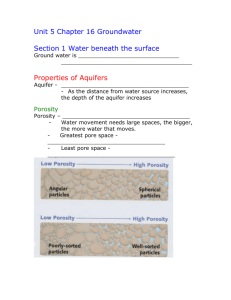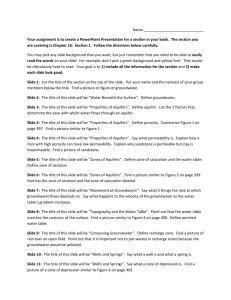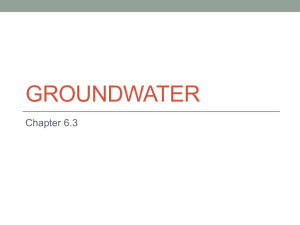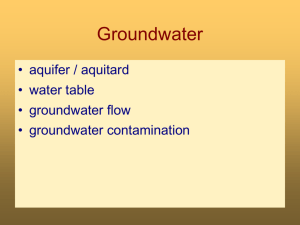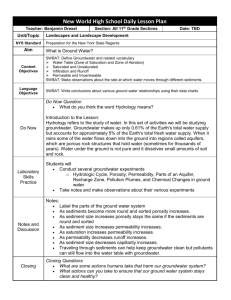14.1 Water in the Ground
advertisement
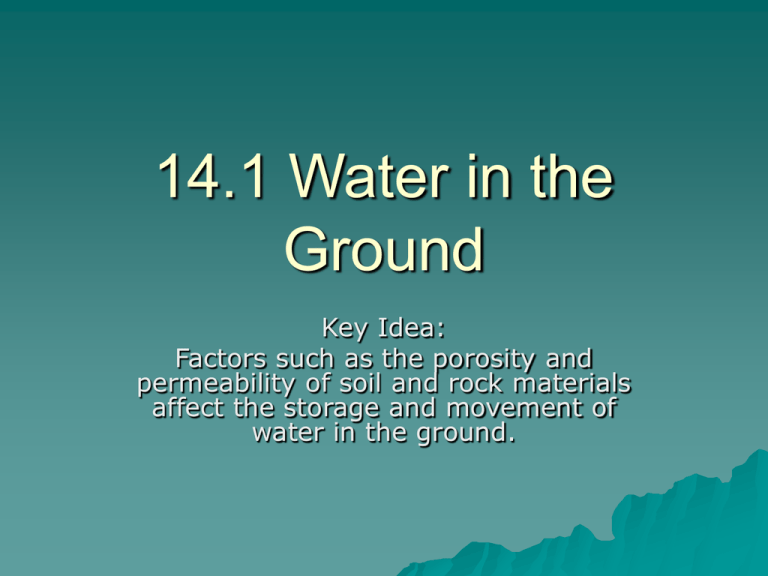
14.1 Water in the Ground Key Idea: Factors such as the porosity and permeability of soil and rock materials affect the storage and movement of water in the ground. Groundwater The natural conditions of a region determine the direction where the water from precipitations goes. For example: -in the mountains, much of the water will flow on the slopes as run-off, and will be collected by streams and rivers. - in the desert the water will evaporate quickly. -in areas with loose soil and rocks that are permeable, much of the water will seep into the ground, and stored as groundwater. Groundwater Properties of Rocks that Allow Groundwater to Accumulate. 1. Porosity Ground water accumulates in rocks that allow the water to seep through. The rocks must have cracks, or spaces in between particles; these spaces are commonly called pores. The property of having pores is called porosity. 2. Permeability The pores must be connected together in order to let the water seep through. The rate at which water passes through the pores of rocks is called permeability. Porosity Porosity depends upon a number of factors, such as: - particles’ shape: materials consisting of rounded particles have more porosity than the materials having angular particles. - sorting: the amount of pore space is is greater in materials that have particles of the same size. Example of Porosity Various Types of Porosity 2. Permeability Permeability differs greatly among rocks: Loose rocks such as gravel and sand have food permeability. Larger grains will have larger pore spaces. The finer the grains of the rock, the less porosity and permeability the rock has. Some rocks have pores but the pores are not connected at all. Pumice is an example of such a rock. Limestone is not a porous rock, but it is has many cracks that make this rock permeable. Aquifers The water that seeps into the ground will be collected in porous rocks, such as sand and gravel; this water will form an aquifer. At the base of all aquifers there is a layer of impermeable rocks. Sometimes there are alternating layers of permeable and impermeable rocks, that might favor the formation of more than one aquifer (like in the above picture). Aquifers The Water Table An aquifer is an accumulation of underground water. The area where water fills the aquifer is called the saturated zone (or saturation zone). The top of this zone is called the water table. The water table may be located only a foot below the ground’s surface or it can sit hundreds of feet down. The Water Table Factors Affecting The Water Table The water table can be at the surface of the ground, such as in swamps and some lakes; its depth depends on many factors: Amount of rainfall Amount of time that passes between rains Season The slope of the ground Thickness of the soil Climate type. Factors Affecting The Water Table In humid climates the water table is close to the surface. In desert regions the water table may be hundreds of yards below the surface. In the woods it is likely to be closer to the surface, where the tree roots can reach it. In hilly country it is closer to the surface in the valleys. Wells Wells provide drinkable water to many people that have no access to other sources of water. People who live in the desert have to dig very deep wells to get the water table. Many rural communities all over the world rely mainly on ground water. A Well Diagram Contamination of Groundwater Springs On a hillside where the groundwater meets the surface, groundwater may flow out as a spring. Afka Spring in Lebanon Artesian Springs Sometimes the aquifers form in hilly areas. If the aquifer is trapped in between two impermeable layers of rocks and it is charged at the top by precipitations, then the water table might be way above the ground level at the base of the hill. If a well is dug at the base of the hill, then the water might spout upward with pressure, rising several feet, or yards above the ground level. This is an artesian well. Artesian Well Artesian Well Hot Springs, Geysers, and Fumaroles Hot springs, geysers and fumaroles are manifestations that are related to magma- tic activity. Hot springs If the ground water travels nearby a mass of hot magma, the water can easily reach boiling point, and its pressure increases. The water comes out the ground as a hot spring. Geysers A geyser is an intermittent hot spring. It shoots hot water and steam into the air at certain intervals of time: weeks, days, or hours. In Yellowstone Park there is one geyser named Old Faithful which erupts every 89 minutes. Old Faithful Fumaroles In areas with recent volcanic activity, where magma is still very hot, the groundwater is heated to the boiling point, and reaches the surface at hot steam. These columns of hot steam are called fumaroles. (The Latin work “fumus” means steam) Fumaroles at Yellowstone National Park


